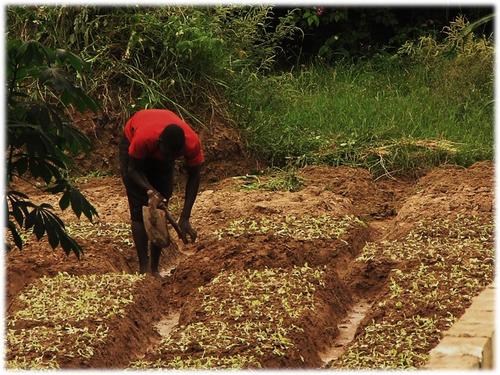Microcatchment water harvesting systems (MicroWH) are designed to trap and collect runoff from a relatively small catchment area, usually (10 – 500 m2) within the farm boundary. The runoff water is guided into an application area where it accumulates in holes, pits, basins and bunds. It infiltrates into the soil, and is used to grow plants. The collected water is stored in the root zone and supplies crops such as sorghum, millet, maize, shrubs, trees or fodder crops. The ratio between the catchment (collection) area to the cultivated (application) area can vary between 2:1 and 10:1. The size of the catchment can be easily controlled by the farmer, which makes the system easy to adapt and replicate. MicroWH are small systems replicated many times with identical designs. Catchment and application areas are alternating within the same field, thus rainwater is concentrated on a confined surface where plants are grown. In comparison, MacroWH are much larger systems with one catchment outside the cultivated area.
Water storage and purpose
The collected water is stored within the soil profile – in the root zone – and used for plant growth. When such systems are applied over a wide area, then there may be significant groundwater recharge.
Most common technologies
Planting pits (e.g. zaï, tassa, chololo), microbasins (e.g. negarim, meskat, triangular / V-shaped bunds, semi-circular bunds, eyebrow terraces, Vallerani type basins), cross-slope barriers (e.g. vegetative barriers / strips, tied ridges, contour bunds / ridges, stone bunds, contour bench terraces).
Applicability
MicroWH is suitable for semi-arid to arid areas with high rainfall variability within seasons. They can be constructed on almost any slope, including nearly level plains – wherever there is overland flow to capture. Soils need to be deep enough to construct holes, pits and to store the collected water. Soils with an inclination to sealing and crusting are particularly suitable for inducing runoff in the catchment area. Furthermore, MicroWH can be applied on highly degraded soils where it can be used in the productive rehabilitation process, reducing erosion and flooding. Further information about the applicability can be found here. (Mekdaschi & Liniger 2013)
Read more about themain benefits, main disadvantages and resilience to climate variability of MicroWH.
